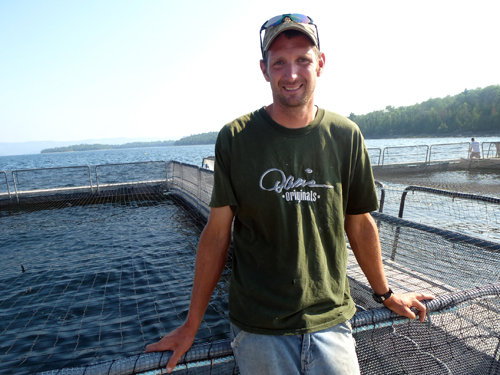By Kelly Daynard, story reprinted with permission from Ontario Farmer

Standing on the dock of the rainbow trout farm at North Wind Fisheries, farm manager Rob Pennie is happy to give a tour to a group of visitors. The farm, located on Great Lacloche Island on the north channel of Lake Huron, benefits from being sheltered but still has good access to cold water flow.
It’s an isolated setting: getting to the farm requires a nine-kilometre drive along gravel laneways. Traffic during Pennie’s morning commute can consist of deer, bears, wolves, turtles, or even Scottish Highland cattle grazing by the side of the lane.
After two years at the farm, Pennie hasn’t tired of the view. “Sometimes it still hits me,” he says with a grin. “I’ll often try to get here 15 minutes ahead of my staff so that I can just enjoy the scenery, and then it’s time to get to work.”
An average workday begins between 6 and 7 a.m. Like many farmers, Pennie says there’s no set end time. “We work until the job is done.”
Pennie grew up on a family farm that raised beef cattle and sheep on Manitoulin Island. Although he always knew he wanted to work with livestock, he hadn’t considered fish farming until he returned home in 2003 after graduating with a bachelor of science in agriculture from U of G.
“My whole intent was to move home and farm,” says Pennie, who still raises beef cattle and sheep when he’s not raising fish. He took a temporary job after graduation with one of the island’s fish farms. Since then, he has built a career in the industry, working his way up to the role of manager at North Wind Fisheries, now owned by Blue Goose.
Fish farming was unheard of on Manitoulin Island until Mike Meeker, now director of aquaculture for Meeker’s Aquaculture, a division of Blue Goose Pure Foods, moved to the island in 1984 with a vision of raising rainbow trout. Today, there are nine rainbow trout sites in the area managed by five farms, and interest is growing from others.
Karen Tracey, executive director of the Northern Ontario Aquaculture Association, says that aquaculture is the fastest growing agricultural sector in the world. In Ontario, fish farms supply about 10 million pounds of farmed trout per year but the demand is three times that.
“An estimated 200,000 pounds of farmed fish come into Ontario monthly from Chile and Peru to meet the demand here,” Tracey explains. “We’d love to be able to fill that.”
On rainbow trout farms, the fish arrive as young “fingerlings” (they’re about the size of a finger). They live in 50-by-50-foot cages or net pens submerged in about 45 feet of water. The cages are covered with a protective netting to prevent hungry birds from feasting on the occupants.
There may be as many as 50,000 fingerlings in a pen but as they grow, they’re divided into other pens to give them more room. It takes between 12 and 15 months for a rainbow trout to reach a market weight of two-and-a-half to three pounds.
Fish farmers use a variety of methods to monitor the health and habitat of their fish. On his farm, Meeker SCUBA dives daily in the summer and weekly in the winter to check his pens. North Wind Fisheries also uses divers and underwater cameras to monitor fish health.
“We’re proud of our record,” says Meeker. “We have very low mortality rates, virtually no disease issues and a high quality product. It’s also important to us to protect the environment that we’re working and living in. We know it’s healthy because of the amount of wild fish living outside of our cages. If it wasn’t, they wouldn’t be there.”
Fish farmers are committed to environmental safety. They must comply with legislation and they require land-use permits to use the water on their shores. Water quality is tested regularly, and farmers keep detailed records of everything they do.
Although there are differences between raising fish and other types of livestock, both Pennie and Meeker agree that the fundamentals are the same. The fish need high energy, low phosphorus feed in precise amounts, constant care and ideal living conditions to thrive.
The weather is a constant focus for fish farmers. “I’m likely checking the forecast four or five times a day,” says Pennie. “I likely check it even more than when I used to decide when to cut hay.”
In the spring, weather monitoring is even more critical when ice on the lakes and in the channel begins to break up. When this happens, Pennie and his staff are on call 24 hours a day. Large sheets of shifting ice can do significant damage to the fish cages as temperatures begin to rise. As a result, farmers use a variety of methods, including water agitators, submersible cages and log booms to help protect their cages from damage.
In the summer, warm weather can also be stressful on trout, so farmers constantly monitor water temperatures and adjust feed levels accordingly for optimal fish health.
After a decade of fish farming in the area, Pennie says he’s learned one key thing: “There’s no such thing as an expert in this industry because every site is different. Things that work on one farm don’t necessarily work at another. At every farm I’ve worked at I’ve learned something new.”
What does he like best? “I love being outdoors and working in agriculture. It’s a great way of life.”
To learn more about rainbow trout farming in Ontario, visit www.ontarioaquaculture.com or www.eattrout.ca.